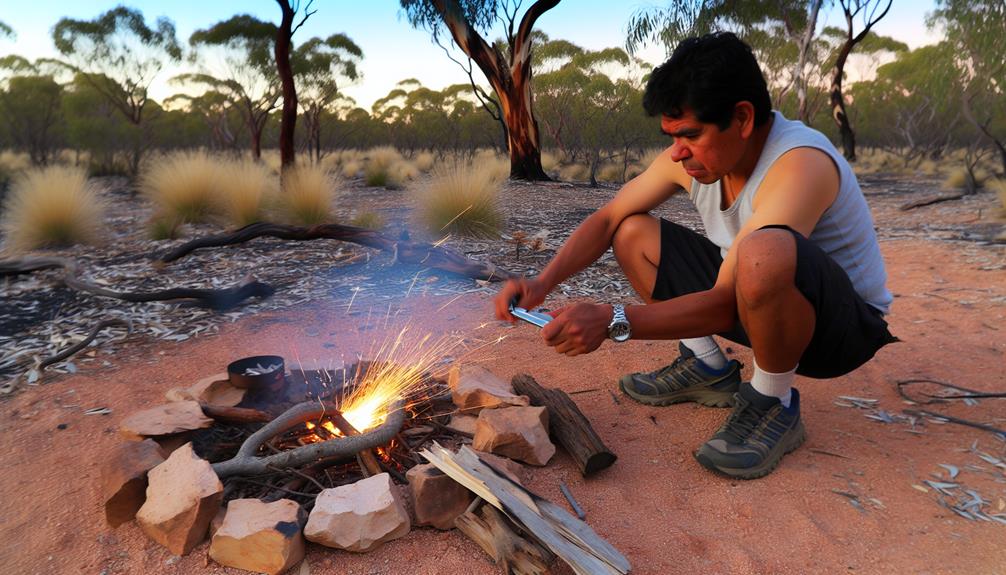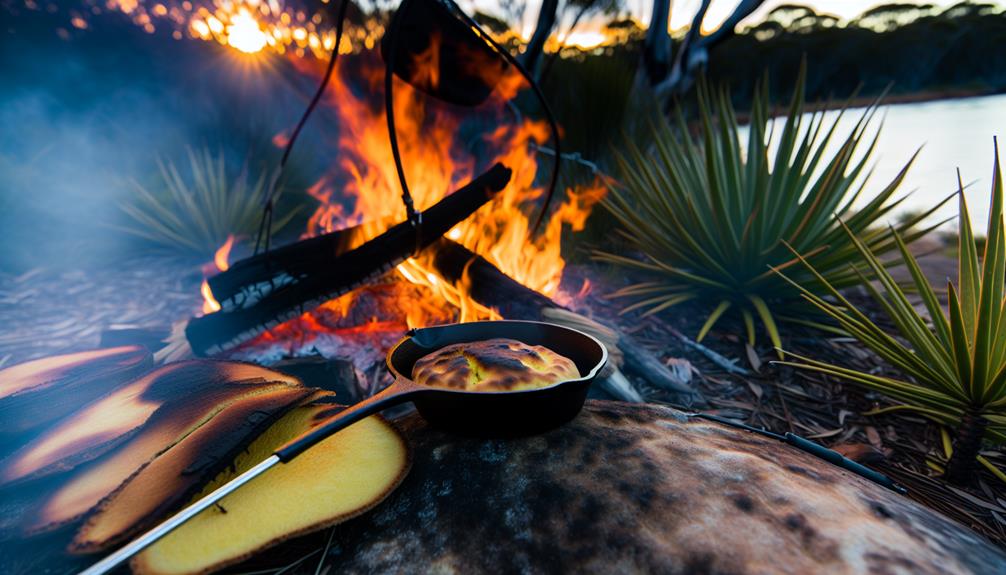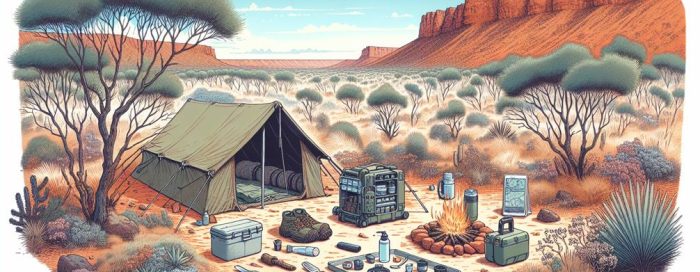When venturing into the Australian bush, preparing for survival is as essential as a compass is for navigation. The vast and diverse terrain of Australia can pose unique challenges for bush campers, but with the right knowledge and preparation, you can ensure a safe and enjoyable experience. From mastering fire starting techniques to understanding water procurement in the outback, there are crucial tips that can make all the difference in your bush camping adventure. So, how can you equip yourself for a successful journey into the wild?
Essential Gear and Equipment
When preparing for bush camping in Australia, ensure you have the essential gear and equipment, including a survival kit, knife, rope, and first aid supplies. These are vital for your safety and preparedness in the outback. Consider a survival gear checklist to ensure you have everything you need, from a reliable knife to a sturdy rope for various tasks. Additionally, camping equipment suggestions should include appropriate clothing and gear for extreme outback conditions. Prioritize hydration and include water procurement and treatment items in your kit. Moreover, consider packing a compass, map, sunscreen, hat, and a signaling device for navigation and safety. By prioritizing these items and being prepared with the right gear, you can ensure a safe and enjoyable bush camping experience in Australia.
Water Sourcing and Purification

When bush camping in Australia, finding clean water is crucial for your survival. Look for water sources such as trees and ground succulent plants, and consider using plastic bags to collect water through transpiration from tree branches. Prioritize water purification methods like boiling, portable filters, UV sterilization, or a lifestraw to ensure safe hydration.
Finding Clean Water
In a bush camping scenario in Australia, securing a source of clean water is paramount for your survival. Waterborne illnesses can be avoided by using proper water collection techniques and purification methods. Here are some ways to ensure a safe water supply:
| Water Collection Techniques | Purification Methods | Precautions |
|---|---|---|
| Locate natural water sources | Boiling | Avoid drinking unfiltered water |
| Collect water from plants | Portable water filters | Prioritize water sourcing over food |
| Create a condensation trap | UV sterilization | Familiarize yourself with purification methods |
| Groundwater exploration | Lifestraw | Carry necessary purification tools |
Purification Methods
To ensure a safe water supply while bush camping in Australia, employ effective purification methods that eliminate bacteria and pathogens from natural water sources. Here are some methods for purifying water:
- Use portable water filters or UV sterilization devices to make natural water sources safe to drink.
- Carry chemical purification tablets or drops for convenient on-the-go water treatment.
In emergency situations, it's essential to utilize natural resources like plants or improvised filtration systems for water purification. These methods can help ensure that you have access to clean and safe drinking water while enjoying the Australian bush.
Hydration Importance
Purification methods ensure safe water supply; now, understand the importance of hydration and water sourcing for your well-being in the Australian bush. Preventing dehydration is crucial for your health and survival. Regularly drinking at least one cup (250ml) of water at a time helps maintain brain function and prevents dehydration, especially in the outback. Larger water intake quantities are essential for clear thinking and decision-making in survival situations. Familiarize yourself with water sourcing methods like transpiration from trees and finding drinkable water in ground succulent plants. It's also important to understand the significance of proper hydration for your overall well-being. Additionally, consider the importance of electrolytes in staying hydrated, especially in hot and dry conditions. Here's a table to help you better understand the importance of hydration and water sourcing:
| Importance of Hydration and Water Sourcing |
|---|
| Prevents Dehydration |
| Maintains Brain Function |
| Essential for Clear Thinking |
| Importance of Electrolytes |
Fire Starting Techniques

When it comes to starting a fire in the bush, you'll want to be well-versed in various techniques. Kindling and tinder, fire steel and flint, and fire starter gel are all effective methods to get a fire going. These techniques are essential for ensuring you can create a sustainable fire for warmth, cooking, and signaling in a survival situation.
Kindling and Tinder
Select dry kindling and tinder materials such as small sticks, dry grass, or bark to ensure a successful fire start in the bush. When choosing the right materials for kindling and tinder, consider the following:
- Kindling:
- Look for small, dry sticks and twigs that easily catch fire.
- Collect a variety of sizes to ensure a steady flame.
- Tinder:
- Use dry grass, bark, or paper to catch fire from the kindling.
- Prepare a sufficient amount to sustain the flame.
Starting a fire without matches or a lighter may require additional skills, such as using a fire starter tool or friction methods. Understanding the characteristics of different materials for kindling and tinder is crucial for effective fire starting in the bush.
Fire Steel and Flint
For effective fire starting in the bush, mastering the use of fire steel and flint is a valuable skill in remote or emergency situations. When using fire steel and flint, safety precautions are crucial. Ensure that sparks are directed away from dry grass or other flammable materials to prevent accidental fires. It's also important to handle the tools carefully to avoid any injuries. Additionally, it's beneficial to have alternative fire starting methods as backups. Carrying waterproof matches or a reliable fire starter can provide additional options for igniting a fire in case the fire steel and flint fail to produce a spark. By being prepared with safety measures and alternative methods, you can confidently use fire steel and flint to start a fire in the bush when needed.
Fire Starter Gel
Consider incorporating fire starter gel into your camping gear for a reliable and efficient method of igniting fires in various weather conditions. Here are some reasons why fire starter gel can be a valuable addition to your camping gear:
- It is easy to use and provides a steady and controlled flame for igniting your campfire or stove.
- This gel is particularly useful in damp or windy conditions where traditional fire-starting methods may struggle.
When using fire starter gel, it's essential to consider alternative options and take safety precautions to ensure a successful and safe camping experience. This compact and lightweight option ensures you have a reliable fire-starting method on your outdoor adventures.
Shelter Building and Safety

When building your shelter in the bush, it's crucial to carefully assess the surrounding terrain and potential hazards for optimal protection and safety. Prioritize emergency preparedness by choosing a suitable location and shelter design to withstand harsh weather conditions. Consider factors such as terrain, wind patterns, and proximity to water sources when constructing your shelter. Use natural materials like branches, leaves, and tarpaulin to build a sturdy and well-insulated shelter. Ensure it is waterproof to keep dry and maintain body heat. Avoid areas prone to flooding, falling debris, or wildlife habitats for safety. Regularly inspect and maintain your shelter for structural integrity and make any necessary repairs. Here's a helpful table to guide you in shelter building and safety:
| Shelter Building and Safety Tips | ||
|---|---|---|
| Choose a suitable location | Construct a sturdy shelter | Ensure waterproof and well-insulated |
| Prioritize emergency preparedness | Avoid hazardous areas | Regularly inspect and maintain |
Navigation in the Wilderness

To navigate effectively in the wilderness, familiarize yourself with the night sky to learn how to use stars for direction. Understanding star navigation can be a valuable skill, providing a reliable method for finding north or south. As you gaze at the night sky, take note of the position of the North Star, which can guide you in the right direction. During the day, utilize the sun-and-stick method: place a stick in the ground and mark the end of its shadow every 15 minutes to determine east and west. Observing the movement of the sun can also help you establish east-west and north-south bearings. Developing these navigation skills will empower you to confidently explore unfamiliar territory and avoid getting lost.
Food for Bush Camping

When bush camping, it's essential to pack non-perishable, high-energy food items such as nuts, dried fruits, and energy bars to sustain your energy levels during outdoor adventures. Additionally, consider lightweight, dehydrated meals that can be rehydrated with water for a quick and easy meal. Bringing along a portable camping stove or compact cookware will allow you to cook meals at the campsite. Don't forget to bring a variety of spices and condiments to enhance the flavor of your camp meals. If you're camping near water bodies, consider fishing as a means of sourcing fresh food. When it comes to cooking techniques, try simple campfire recipes for a delightful outdoor dining experience. From foil-wrapped potatoes to grilled vegetables, campfire cooking can add a fun and flavorful dimension to your bush camping experience.

